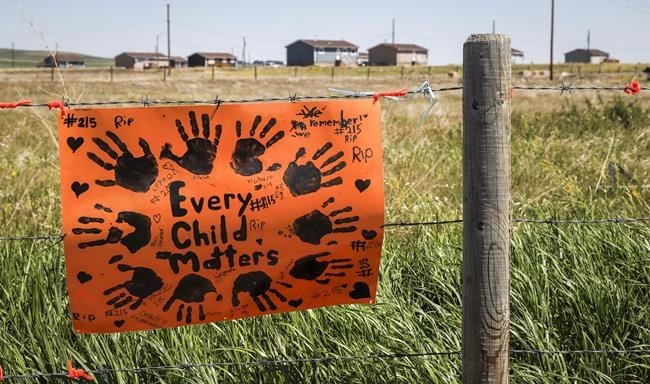SADDLE LAKE CREE NATION — A new report from a group looking into children who died and went missing at a residential school northeast of Edmonton says unpasteurized milk was responsible for the deaths of Indigenous children at the institution.
The preliminary report was released Tuesday by the Acimowin Opaspiw Society, formed by the Saddle Lake Cree Nation in 2021 to investigate the Blue Quills residential school.
"I definitely see genocide at play," said Leah Redcrow, executive director for the society.
Researchers went through historical records from school administrators, nurses and the church. They found that doctors would check the children to make sure they were healthy entering the school, the report said, but many became sick soon after.
Redcrow estimates up to 400 children died while attending the school between 1898 and when it closed in 1990.
The school was started by Roman Catholic missionaries in Lac la Biche but later moved to the Saddle Lake Cree Nation. It was relocated again in 1931 to St. Paul, about 150 kilometres northeast of Edmonton.
In 1970, parents of children at the Blue Quills school occupied the institution and demanded its operation be turned over to the First Nation. It became Canada's first residence and school controlled by First Nations people.
Survivors told the Truth and Reconciliation Commission, which looked into the legacy of residential schools across the country, about humiliation, labour and physical and sexual abuse at the Blue Quills residential school. They also spoke about hunger, disgusting food and being forced to eat everything they were given.
For decades, the school had its own milking cows that were purchased by the Department of Indian Affairs. The animals were not being tested for bovine tuberculosis or other diseases, the new report said, even when concerns were raised.
The report found the children were being fed the unpasteurized milk at three meals each day and later many developed tuberculosis and other diseases.
School staff and administrators had their own pasteurized dairy products, Redcrow said, and they were healthy.
"They are playing Russian roulette with these kids' lives," she said.
The Truth and Reconciliation Commission's report on missing children and unmarked graves found that Alberta residential schools had the highest number of student deaths. Half of the deaths didn't have a cause identified. When it did, many were due to infectious disease.
"I know that they knew," Redcrow said about school staff. "How I know that they knew was because they weren't drinking that milk and they weren't getting sick."
Redcrow said an important discovery for researchers was learning that records of the children's deaths were not held within the residential school's files, but instead with the local parish. Their local parish, Sacred Heart, provided the documentation and researchers began to find names of students, she said.
Redcrow said oftentimes records showed that when a child died, their parents weren't notified.
The discovery about where records are held will give researchers the ability to tell living family members what happened to the students who never returned home, Redcrow said.
She added, however, that some children just disappeared from school records, including a member of her own family.
Redcrow said her great-grandfather Edward Redcrow, who was also sent to residential school, had 14 children with his first wife. Only four of their children came home from the institution.
One of the children, Eva, was last recorded alive in the residential school. Redcrow said there are no burial records nor vital statistics that say Eva died. But she never made it home.
The society's report also said a mass grave was identified 200 metres north of the residential school site by an accidental excavation in 2004. It was confirmed by ground-penetrating radar last year. There were no records of it in church or school documents that could explain its location, the report said.
Additionally, community members have identified two other sites of possible graves which will be prioritized for investigation later this year when weather allows for fieldwork. Community members have also found loose children's bones in a graveyard in areas where they shouldn't be, the report said.
Redcrow said there is still a significant amount of work to be done, including translating decades of church documents and further on-site excavation. But finding answers for families and giving voice to missing children motivates the work, she said.
"It's vital," she said. "It's so important."
This report by The Canadian Press was first published Jan. 25, 2023.
— By Kelly Geraldine Malone in Saskatoon
The Canadian Press


